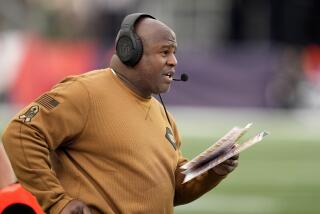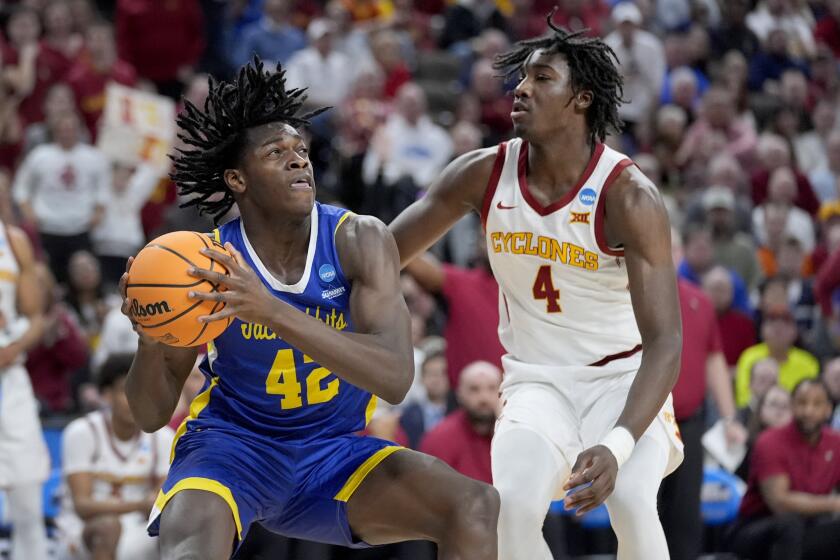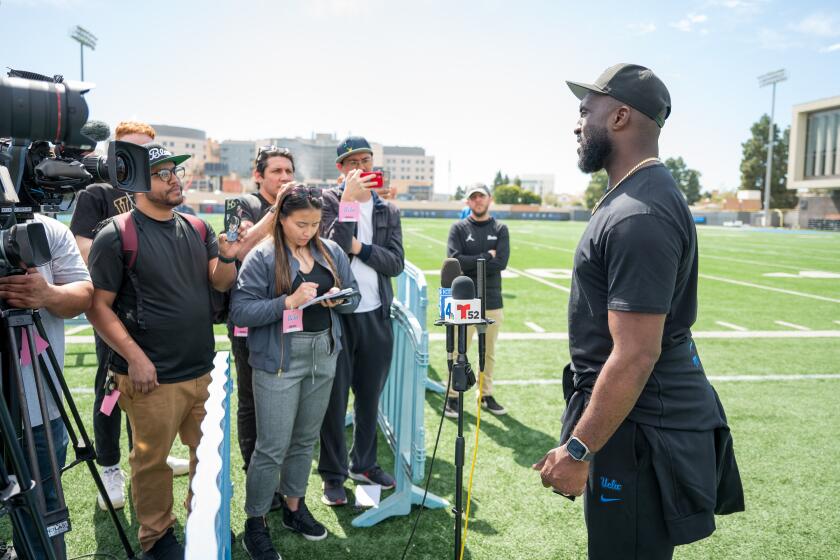In Chip Kelly, UCLA gets coach who ‘revolutionized’ college football

In the winter of 2007, Mike Bellotti was struggling to ignite his offense at Oregon.
The Ducks football coach had tinkered with the spread formation but, after a couple of seasons, wasn’t getting the results he wanted. So he went looking for help.
Oregon hired a 43-year-old assistant named Chip Kelly who had spent years quietly developing a version of the up-tempo scheme at tiny New Hampshire.
“My philosophy has been to coach an attacking style of football,” Kelly said at the time. “And stretch the defenses in as many different ways as you can.”
Major college football would soon be introduced to a man who would alter the way the game was played, a man who is assuming control of UCLA’s beleaguered program.
Kelly will be introduced Monday as UCLA’s football coach. The school announced his hiring Saturday morning, less than 10 hours after the Bruins — under the direction of interim coach Jedd Fisch — defeated California, 30-27, in their final regular-season game. Kelly received a five-year, $23.3-million contract.
“He’s obviously a tremendous coach who understands the concepts of spreading the field and creating opportunities for big plays,” said Bellotti, now an analyst for ESPN. “I also think he’s a very good evaluator of talent and a very good recruiter.”
To say that Kelly invented the hurry-up offense would be an overstatement — he built on the work of others, including Rich Rodriguez, the current coach at Pac-12 Conference rival Arizona.
Oddly enough, the New Hampshire graduate began his coaching career by working with defensive backs and special teams at Columbia University in 1990. After bouncing around for a few years — including a season as defensive coordinator at Johns Hopkins — he returned to his alma mater as the running backs coach in 1994.
Within five years, Kelly had worked his way up to offensive coordinator and started experimenting.
His influences dated to pioneers such as Dutch Meyer and Knute Rockne. He visited Clemson, where Rodriguez was becoming a spread guru under then-coach Tommy Bowden.
“I will study anybody,” Kelly said.
New Hampshire developed a team that averaged more than 400 yards and better than 30 points a game at the Division I-AA level. In 2005, Kelly was named assistant of the year.
“He had a knowledge of the spread offense and the no-huddle stuff that we were trying to do but it was in the infancy stages,” said Bellotti, who had lost his previous coordinator to another school. “I knew he was much better prepared to help us take a step forward without taking two steps backward.”
That first season in Eugene, the new coordinator’s “Shred Offense” ranked among the national leaders, averaging 476 yards a game. Pete Carroll, then coaching USC, called it “ridiculously effective.”
Oregon wasn’t about to let Kelly slip away, naming him as Bellotti’s successor and promoting him to head coach before the 2009 season.
The Ducks’ attack, evolving from “Shred” to “blur,” was based on breakneck pace. That meant squeezing 80 plays into each game, no time for huddles or standing around at the line of scrimmage.
If Kelly had directed “Gone With the Wind,” he joked, the film classic might have turned out different.
“Get right to Atlanta, burn the buildings and yell ‘time,’ ” he said in a 2010 interview.
Oregon players and fans wondered if opponents were faking injuries just to catch their breath. Kelly goaded officials to spot the ball as fast as possible after each play.
“That tempo they were going at kind of wore us down,” Tennessee defensive lineman Chris Walker said after a 2010 game.
Up-tempo did not translate into all passing. Kelly valued the run game and made alterations based on his personnel from season to season.
Yet as the touchdowns piled up, Oregon fell short in big games, losing the Rose Bowl in Kelly’s first season, then dropping a 22-19 heartbreaker in the 2011 Bowl Championship Series title game as Auburn defensive lineman Nick Fairley overpowered the offensive line.
“It was just a tough matchup for us,” Kelly said.
Though the Ducks broke through with victories in the 2012 Rose Bowl and 2013 Fiesta Bowl, Kelly would not get another shot at the championship.
This failure in no way diminished his influence on the rest of college football, as teams across the nation began adopting elements of the blur.
“Whenever anybody is successful in a particular way, there’s going to be a lot of plagiarism,” said Rick Neuheisel, the former UCLA coach. “That’s just part of the deal.”
Kelly said: “We don’t try to set trends. It just worked best with the players we had.”
Success generated interest from NFL teams. The Tampa Bay Buccaneers were reportedly close to signing Kelly in 2012. The next winter, the Philadelphia Eagles and Cleveland Browns interviewed him.
After his team defeated Kansas State in the Fiesta Bowl, Kelly insisted he would remain in the college ranks, then abruptly swiveled and signed with the Eagles.
Within a few months, Oregon acknowledged paying $25,000 to a recruiting service that had connections with a highly touted prospect. The NCAA eventually stripped the Ducks of scholarships and placed them on three years’ probation. Kelly was given an 18-month show-cause order, meaning any NCAA school that wanted to hire him would have to justify the choice.
But Kelly was already gone from the college game by then, starting a new chapter in his career amid both curiosity and skepticism about what he might bring to pro football.
Hall of Fame coach John Madden speculated Kelly might have “as much influence on the game and the way it’s played now as anyone.”
Another former coach, Jon Gruden, disagreed to some extent: “If I read one more article about Chip Kelly’s tempo, I might throw up. Chip Kelly didn’t invent the no-huddle offense.”
But Gruden added: “The guy knows offensive football.”
The Eagles improved from 4-12 to 10-6 in his first season at the helm and earned a spot in the wild-card playoff round, where they lost 26-24 to New Orleans.
The next summer, former USC quarterback Mark Sanchez joined the team and noticed a difference.
“One of Coach Kelly’s things is to be able to communicate as fast and efficiently as possible,” Sanchez told The Times. “With the team picture, he gave us five minutes to get ready. He’s like, ‘We’re not drawing this thing out. This is going to be the most-efficient team photo in the history of the NFL.’ He’s like, ‘Line up in numbered order. Get there. Now.’
“I was like, ‘Whoa, I’ve never seen guys run to a team picture,’” Sanchez said.
Philadelphia went 10-6 again in 2014 but failed to reach the postseason. Kelly then made a bold move, taking control of the player personnel department and making a series of controversial changes.
Quarterback Nick Foles was traded for the talented but oft-injured Sam Bradford. Leading rusher LeSean McCoy was dealt away, replaced by DeMarco Murray.
The offensive line and defense were reshuffled as well.
“We weren’t trying to make news,” Kelly said. “We were just trying to make our team better.”
But the Eagles weren’t better, stumbling to a 7-9 record. A week before the regular season ended, owner Jeffrey Lurie fired the coach.
Though the San Francisco 49ers quickly signed him, Kelly did not do any better in 2016, inheriting less talent in a tougher division. Injuries did not help as the 49ers finished 2-14 and fired Kelly in January.
During his time away from college football, teams across the nation continued to both adopt the hurry-up and adjust to defending it.
The man who now becomes UCLA’s coach had made his mark.
As USC Coach Clay Helton told The Times last fall: “Chip’s one of those guys I think revolutionized the game and probably changed the college game forever.”
Follow @LAtimesWharton on Twitter
More to Read
Go beyond the scoreboard
Get the latest on L.A.'s teams in the daily Sports Report newsletter.
You may occasionally receive promotional content from the Los Angeles Times.







